
15 Dec The hidden mini statues of Budapest
What do a murdered squirrel, a tiny tank and a Hungarian puppet have in common? No, this isn’t some weird riddle; they are all the artistic antics of Mihály Kolodko, a guerilla sculptor, a Ukrainian citizen with Hungarian origins, who was born in the Transcarpathian city of Uzhhorod (Ungvár).
Like Pokemon, his mini statues keep popping up throughout the city, so be on the lookout for the next whimsical installations. We have no idea what Kolodko will think of next but we are excited to find out. In this article, we’re going to look at some of Mihály Kolodko’s prominent mini statues.
Below this article, you will find a comprehensive map indicating all these mini statues.
Sign up for our small-group walking tour to learn more about the mini statues and understand Budapest’s history and culture throughout the background stories of the artworks.
Dead Squirrel
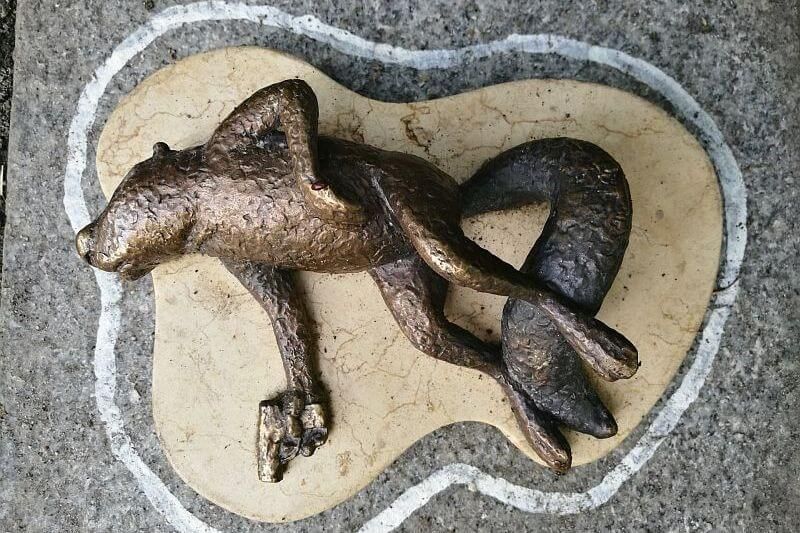
Photo: welovebudapest.com
Wandering down beautiful tree-lined Falk Miksa Street you wouldn’t expect to come across a murdered squirrel, his body outlined by chalk and his hand clutching a gun.
We don’t exactly know what happened to the furry victim (was it a homicide or suicide? Is the perpetrator still at large?). Lucky enough for the squirrel he was murdered next to the Columbo statue so it’s a case that he’s sure to be able to crack.
The Dead Squirell
Kermit the Frog
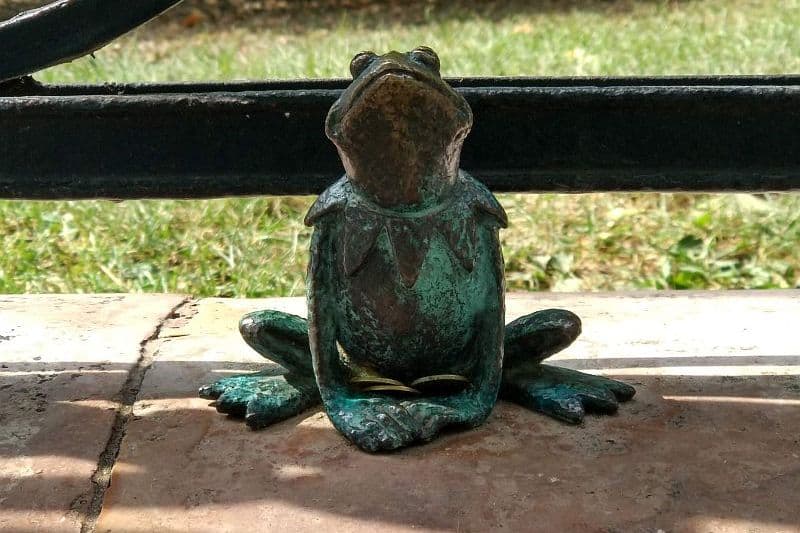
Photo: budapestflow.com
If you are wandering along Szabadság Square (Liberty Square) near Parliament you could very well miss Kermit the Frog if you don’t happen to look down. Nestled next to the fence overlooking the square’s café you’ll find this beloved Muppet.
While the statue was created to recognize when frog legs became a Hungarian delicacy in the late 19th century, don’t worry! Kermit is well-loved and not likely to be eaten. If you happen to see him during the winter months, you may find that someone has dressed him in a cozy little scarf (because it can get awfully cold in the snow).
Kermit The Frog
Főkukac
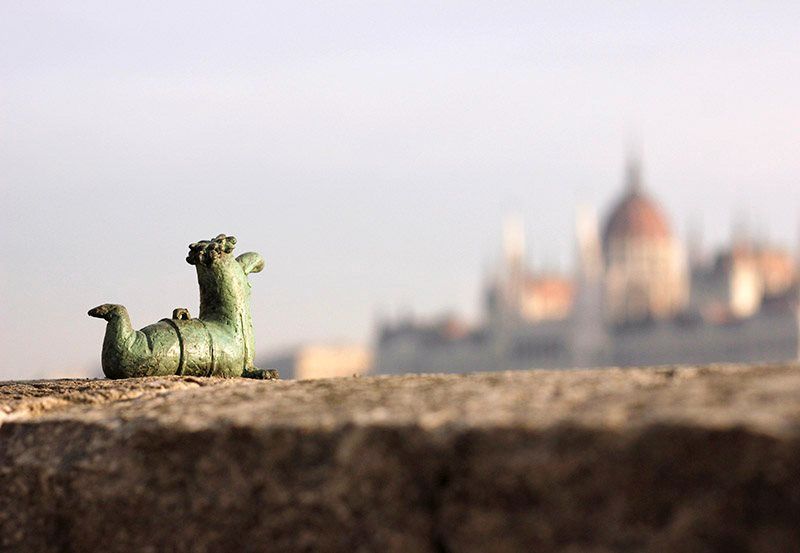
Photo: kolodkoart.com
If you grew up in Hungary then you may remember the TV series, “A Nagy Ho-ho-ho Horgász” (“The Big Ho-Ho Angler”) about an oafish fisherman and his bait. It seems only fitting that Kolodko’s first miniature statue would be the show’s character Főkukac, a happy little worm who is no longer bait but instead leads a much better life sitting on the banks of the Danube at Bem Quay 15.
If you’re a fisherman you may want to stop and rub Főkukac’s nose for good luck (it certainly couldn’t hurt, right?).
Főkukac
Tiny tank

Photo: kolodkoart.com
Many of Kolodko’s guerilla sculptures may be small but they offer a powerful message, including this mini tank, also found near the riverbank on Bem Quay.
This tank symbolizes Hungary’s 1956 revolution, as indicated by the bold white letting “Ruszkik Haza!” (“Russian’s go home!”) etched on the side of the tank. While the tank is facing Parliament its gun is facing downward to signify the end of the revolution.
Tiny tank
Ferenc Liszt
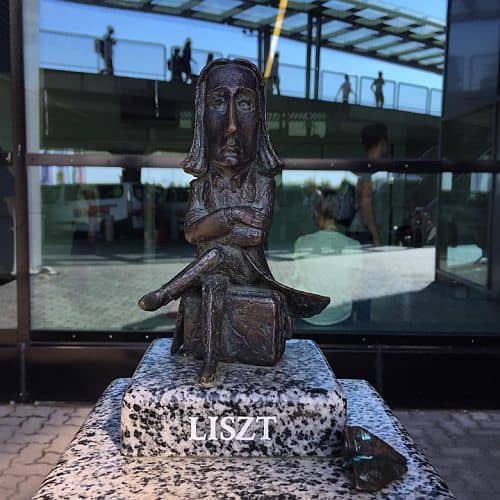
Photo: instagram.com/statuesofbudapest
Ferenc Liszt, the world-famous Hungarian composer, may be gone but he’s certainly not forgotten. In 2011, on the day of Liszt’s 200th birthday, a miniature statue in his likeness was placed at the Terminal 2A bus stop outside the airport.
It’s a fitting place for the accomplished world traveller (who can be found sitting on his suitcase), seeing as the airport was named in his honour.
Liszt Ferenc
Mekk Elek
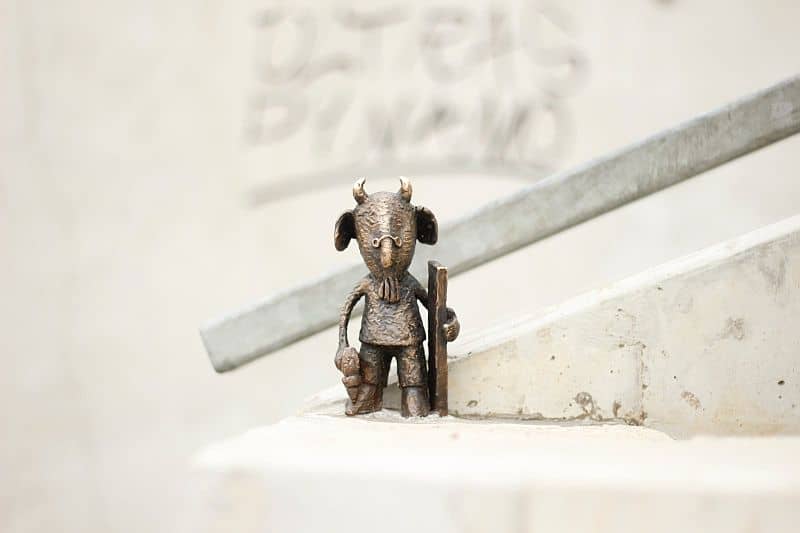
Photo: kolodkoart.com
If you were watching Hungarian cartoons in the 70s then you might remember the loveable Mekk Elek, the handyman goat who was endearingly inept. While he tries his hand at many different skills, it seems that Mekk Elek isn’t really cut out for any of them.
Luckily, he is cut out to be an adorable mini statue at the foot of the stairs of Széll Kálmán Square near the Castle and luckily for all of us, he isn’t doing any repairs.
Mekk Elek
Libido
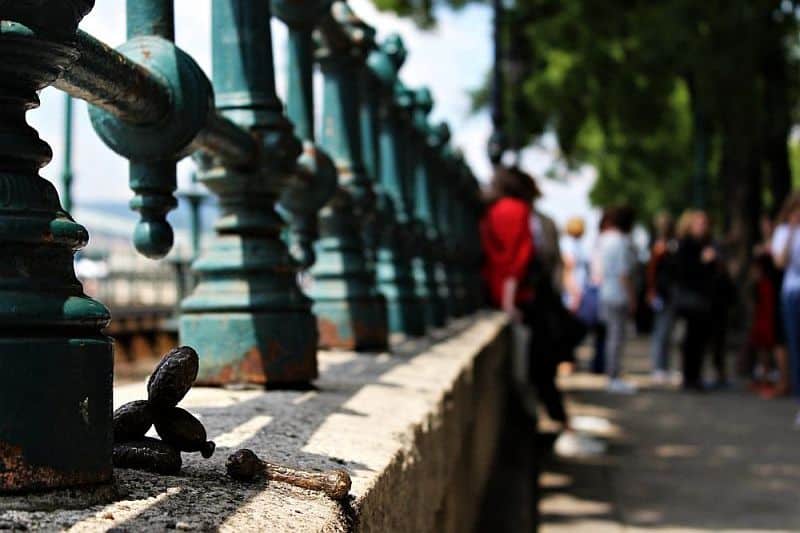
Photo: szeretlekmagyarorszag.hu
You’d have to be on the hunt for this mini statue at the Pest entrance of the Chain Bridge in order to find it. Placed between the iron fence posts near the Corso Restaurant lies Libido, a balloon dog and homage to the scandalous artist Jeff Koons who is also known for his balloon animals and inflatable sculptures.
Luckily, for this little guy, he’s not made from rubber so he can withstand the city’s elements and not fall prey to mischievous visitors.
Libido
Tivadar Herzl

Photo: szeretlekmagyarorszag.hu
Tivadar Herzl was a Jewish Austrian-Hungarian journalist, writer and political activist who became known as the father of modern Zionism.
Today you’ll find a tiny sculpture of Herzl with his bike (most likely inspired by a photo taken of Herzl with his bike in Austria) appropriately placed near the iconic Dohány Street Synagogue in the 7th district. On Dohány Street, not too far from his miniature likeness, you’ll find his birth site, which is now the Jewish Museum.
Tivadar Herzl
Rubik’s Cube
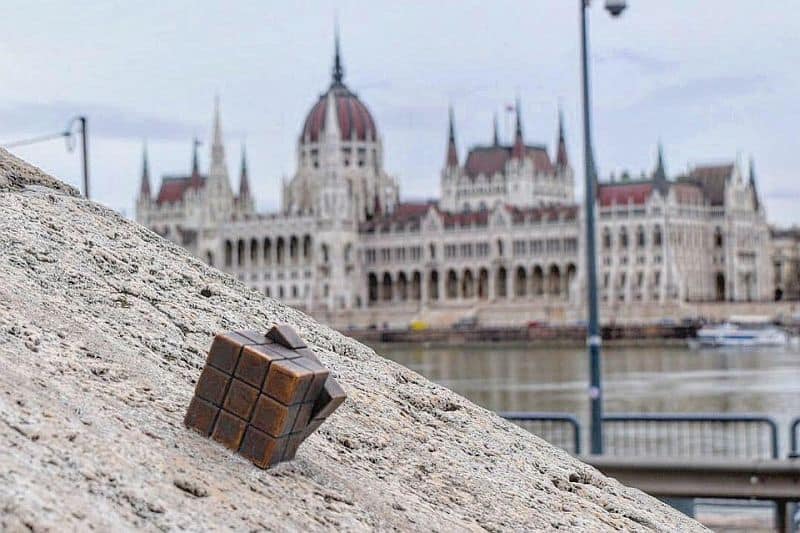
Photo: instagram.com/statuesofbudapest
Did you know that this popular puzzle toy is a Hungarian invention? So it should come as no surprise that Kolodko wanted to commemorate the Rubik’s Cube by making it into a miniature statue.
While you won’t be able to solve this puzzle you can enjoy its clever craftsmanship by heading to the Buda riverbank near Batthyány Square where you’ll find it opposite Parliament.
Rubik’s Cube
Diver

Photo: welovebudapest.com
If you’re headed to the famous New York Café you’ll find the “key” to the café resting in the hands of a diver at the intersection of Dohány Street and Osvát Street. Legend has it that the Hungarian author Ferenc Molnár tossed the café’s key into the river to prevent it from ever closing.
Perhaps Molnár’s outburst worked, as the café is still just as popular today as it was at the turn of the 20th century.
Diver
Lunar Rover

Photo: facebook.com/kolodkoart
Being a nation of inventors, it’s never a surprise that a Hungarian turns out to be behind an innovative new piece of technology. Ferenc Pavlics escaped to the US after the 1956 Revolution and ended up working for NASA.
It was he who came up with the lightweight but resilient wheels needed to traverse the Moon on the Lunar Rover. Pavlics was given a NASA award for his achievement. Appropriately, this one can be found on Hold (Moon in English) street on its own moon-shaped bollard.
Lunar Rover
Urinal

Photo: instagram.com/statuesofbudapest
One of Kolodko’s oldest (and easiest to miss) works. This one is tucked away on the wall surrounding Vajdahunyad Castle moat.
A tribute to Marcel Duchamp’s controversial 1917 sculpture, Fountain (itself a signed porcelain urinal), we’re left guessing at the Kolodko’s intentions. Is he alluding to the lack of public toilets in the area? Or is he literally just taking the piss?
Urinal
Rezső Seress
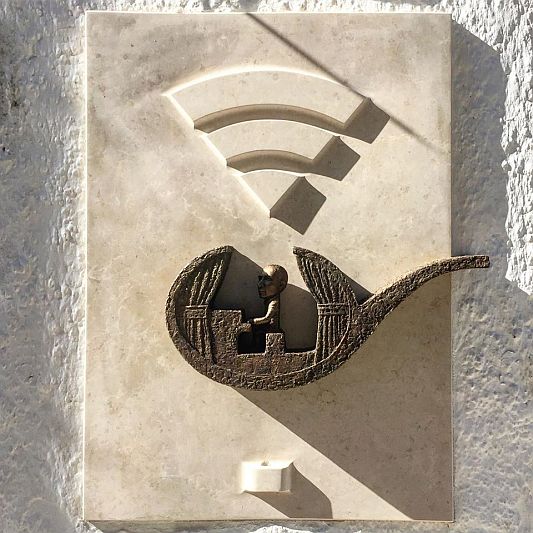
Photo: instagram.com/statuesofbudapest
Gloomy Sunday, bleakly and infamously known as the Hungarian Suicide song due to the supposed influence it had on suicide rates in the ‘30s, was the work of Rezső Seress, who lived and worked in the Kispipa bar in District VII. A survivor of WWII labour camps and a former trapeze artist, Seress focused on songwriting after an injury.
He could have collected a fortune in royalties for the song in the US, but instead stayed in the bohemian bar, writing, playing the piano and singing for the clientele. Years of depression followed and, after surviving a suicide attempt from the upstairs window. This tribute to his talents is on the wall of the former Kispipa restaurant.
Rezső Seress
Checkered-Eared Rabbit
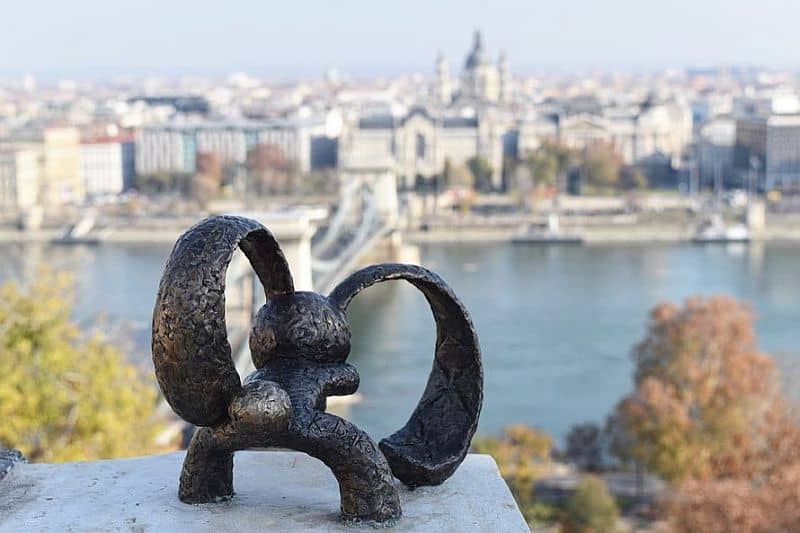
Photo: instagram.com/statuesofbudapest
Continuing his nostalgic-look into Hungarian TV history, Kolodko presented the kockásfülű nyúl (checkered-eared rabbit) in November 2018 at the top of the Castle Hill Funicular.
Written in the 1970s by Veronika Marék and animated by Zsolt Richly, the show gained belated popularity around the world, especially in the US where it was shown on Nickelodeon after the fall of the Communist regime.
This floppy-eared bunny has a bird’s-eye view of the city, surveying the Danube through her telescope.
Checkered-Eared Rabbit
Hanna Szenes
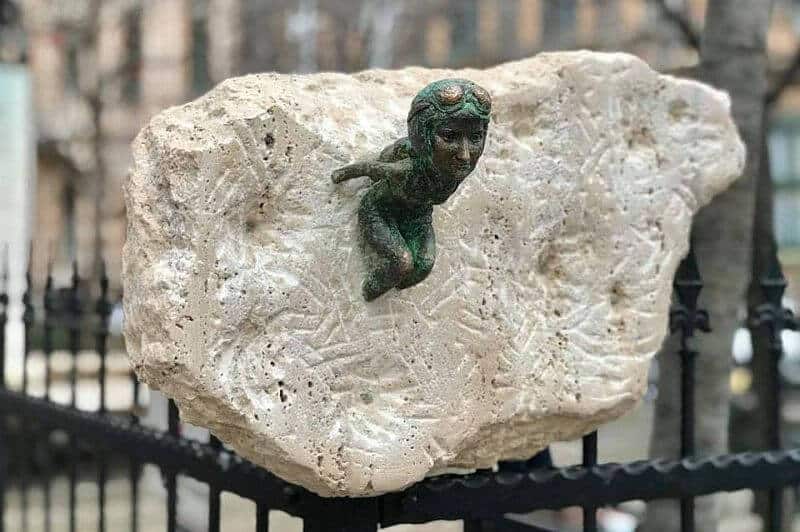
Photo: facebook.com/hosszulepes.jarunk
On International Women’s Day 2020, Hosszúlépés. Járunk? partnered with Mihály Kolodko to produce this wonderful tribute to a Jewish war hero, Hanna Szenes. Szenes volunteered to parachute into Yugoslavia during World War II in order to assist anti-Nazi forces.
Despite being safely away from the Holocaust (living in the British Mandate of Palestine), she enlisted in the British Women’s Auxiliary Airforce to work with partisans disrupting Nazi activity and preventing deportations to concentration camps.
Parachuting safely into Yugoslavia, Szenes learned that Hungary was now Nazi-occupied. Nevertheless, she continued onwards towards the border, where she was arrested by Hungarian guards, before being imprisoned, brutally tortured and executed. She had refused to reveal the information her captors sought.
This tribute to an incredibly brave woman is also part of the #wonderwomenbudapest initiative which aims to rebalance the gender divide in the city’s sculptures.
Hanna Szenes
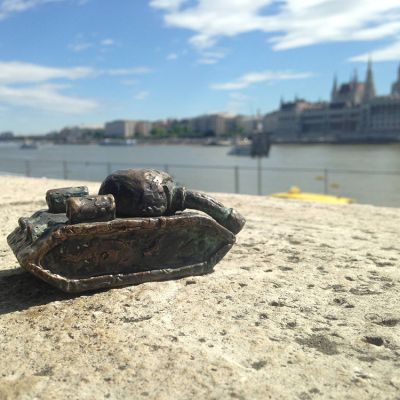
Join our Mini Statues Tour
Discover an unique features of Budapest’s public art scene: the mini statues and learn about Budapest’s history and culture throughout the background stories of the artworks.
“Amazing walking tours with great insights”
SAPHINA (USA), January 2017
Axe
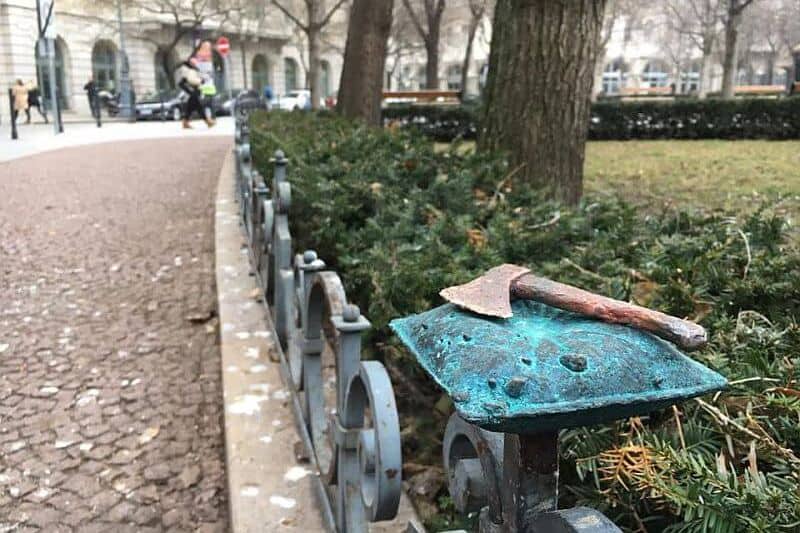
Photo: facebook.com/kolodkoart
Liberty Square has long been an ideological battleground, with controversial monuments from every political era of Hungary’s history standing shoulder to shoulder and Kolodko audaciously entered the fray in 2019 with his Ushanka (Russian Hat) mini-statue, criticising a perceived continuing Russian influence in Hungarian politics.
Unfortunately, one far-right politician didn’t take too kindly to it, destroying the statue with an axe and throwing it into the Danube. The sculptor responded with this sardonic comeback, both mocking and memorialising the violence of his aggressor.
Axe
14-Carat Roadster
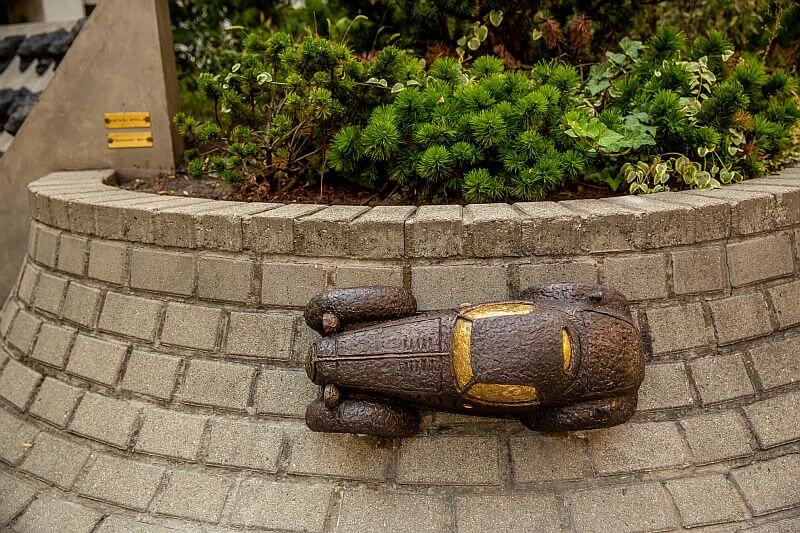
Photo: welovebudapest.com
Amongst his seemingly innocuous sculptures of children’s stories and old TV shows, Mihály Kolodko has shown an inclination for celebrating the Jewish history of District VII.
As well as his pieces on Hannah Szenes and Rezső Seress, there’s also this ritzy memorial to the work of writer Jenő Rejtő, another Jewish resident who wrote fantastical, breakneck-paced pulp fictions stories. The 14-Carat Roadster is one of his most famous tales and can be found right in front of the Pesti Magyar Színház.
14-Carat Roadster
Noah’s Ark
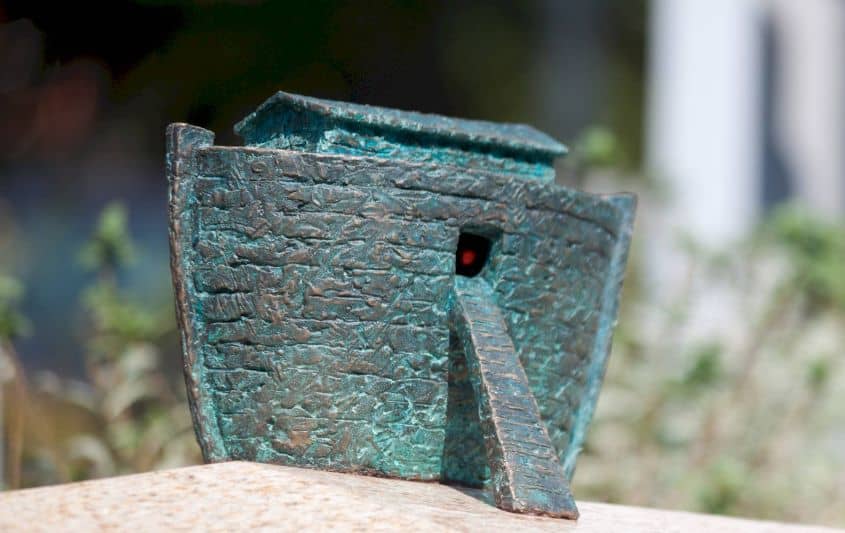
Photo: kozterkep.hu
It’s worth finding the precise time of day to see this Ark, waiting until the sun hits just the right spot. If you do, you’ll be rewarded with the rainbow that symbolised the end of the flood, recreated in its beautiful multicoloured windows.
This was unveiled (along with the Roadster and Diver) in August 2019 and marked a period when Kolodko’s mini-sculptures started getting a little less…mini.
Noah’s Ark
Pair of dray horses
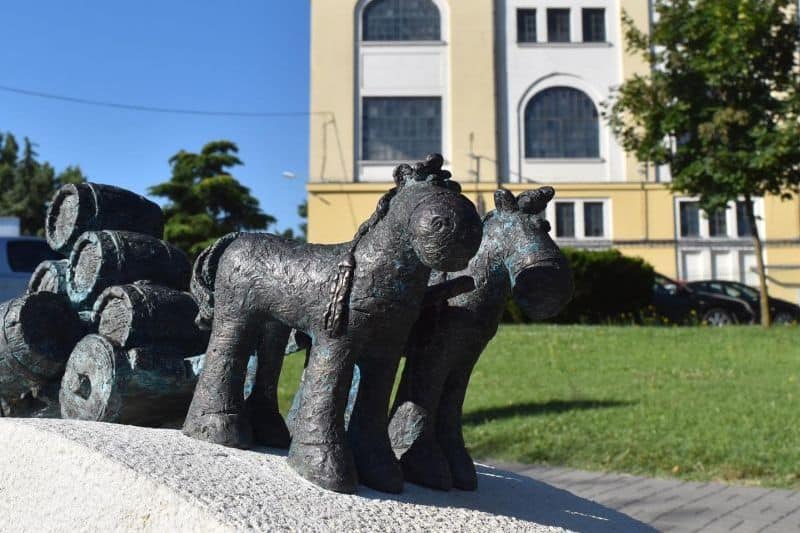
Photo: facebook.com/statuesofbudapest
It may be a little detour from the city centre, but the 160-year-old Dreher Brewery in Kőbánya is worth a visit, especially now that is boasts not one but two new Kolodko works. On the gate you can see a pair of dray horses pulling barrels of the good stuff, but venture inside and you’ll see the man himself: Antal Dreher Sr.
Dreher was an Austrian who revolutionised the beer-making process with his new bottom-fermented Lagerbier, which won Gold Medals in Paris, Vienna, and even far off in Sydney. By the time of his unexpected death in 1863, he’d bought the Kőbányá Brewing Company, sowing the seeds for Hungary’s best known beer.
Dreher maintain a Beer Museum at their 10th District works, so you can learn all about the process yourselves – as well as seeing Kolodko’s latest nod to Budapest history.
Pair of dray horses
Brexit
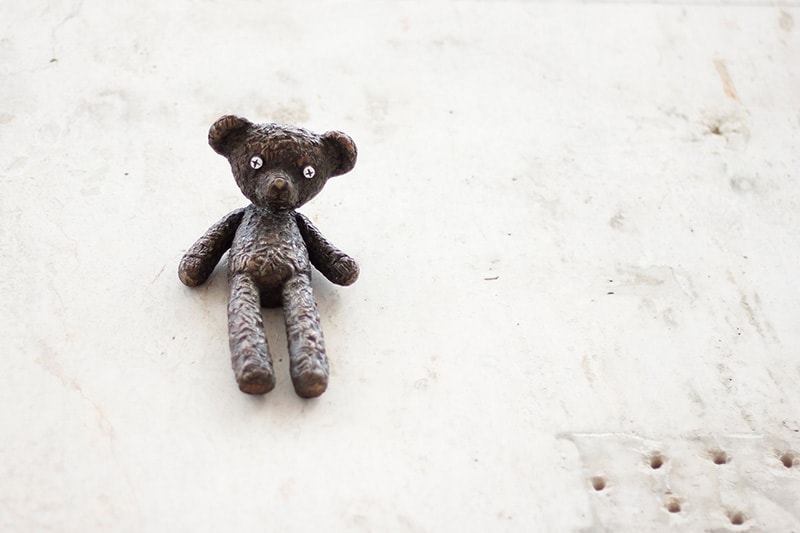
Photo: facebook.com/kolodkoart
With the UK finally exiting the European Union after a protracted withdrawal period, Kolodko has decided that we all need a bit of comforting with his latest piece, Brexit.
Mounted on the wall of the former British Embassy at Harmincad utca, this bear will be instantly recognizable to most as Mr. Bean’s beloved Teddy. In divisive times, it may help bring a little comfort to a fractured union.
Brexit
Franz Joseph
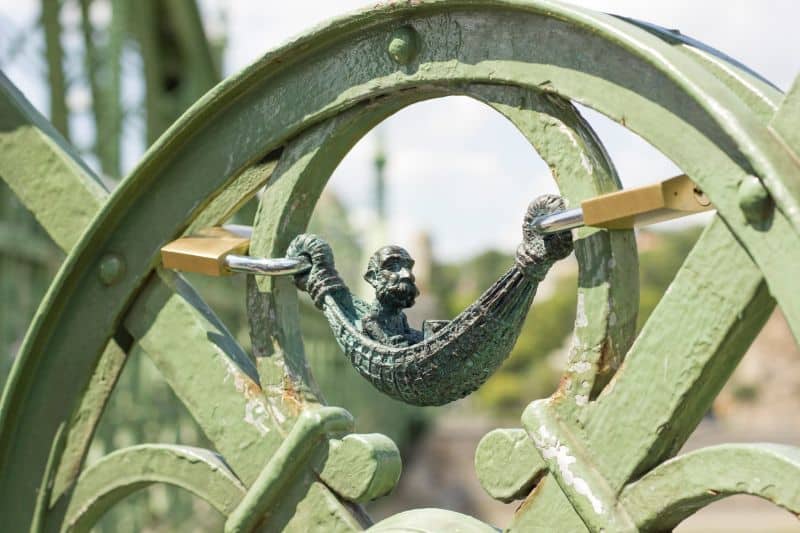
Photo: facebook.com/kolodkoart
In May 2021, the Austrian Emperor (and former King of Hungary of course) Franz Joseph appeared on Liberty Bridge. The choice of location was significant, as the bridge used to bear the Habsburg ruler’s name – in fact, he hammered in the last rivet to complete construction (the rivet was made of silver, no less!).
As for the hammock – well, that refers to the folks who took over the bridge while it was closed to road traffic a few years back.
Hammocks hung high from the bridge’s cables as people took the chance to relax and chill in one of Budapest’s most iconic spots.
Franz Joseph
Lecsó (Ratatouille)
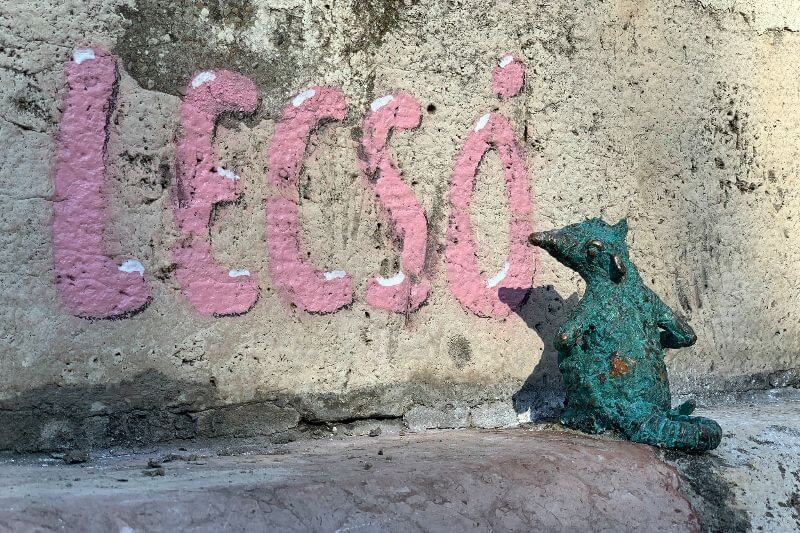
Photo: facebook.com/kolodkoart
In this case, the mini statue might actually be real size, since it represents a (gastro)rat, a clear reference to the famous Pixar movie, the Ratatouille.
Entered in Budapest’s scene in the late summer of 2021, this Kolodko’s work seems to be an homage not only to the famous movie character but to Banksy, and to Hungarian cuisine, at the same time.
Located on the Buda end of Elisabeth Bridge, the cartooned rat is spraying the word ‘lecsó’, which is the name of an iconic Hungarian dish, vaguely similar to ratatouille, a stew of peppers best enjoyed from late August, and at the beginning of autumn.
The (agreeably cute) sculpture, reminds us of Banky’s early works. The mysterious British artist, in fact, started his career representing rats, a symbol for the nature of street art: it might fade away, but it tends to come back!
We certainly hope that this one will stay, to welcome the new season with the flavor-rich Lecsó!
Lecsó (Ratatouille)
The Russian Warship
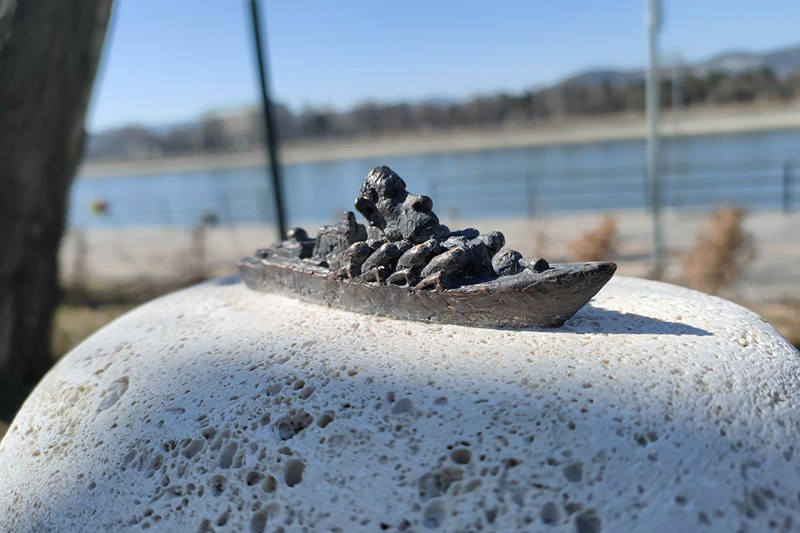
Photo: budapestflow.com
In a scenario globally shaken by the war in Ukraine, Hungarian-Ukrainian artist Kolodko could not just stand still. His new mini statue in Budapest represents Putin on a warship. This statue is actually big, as the miniature lays on a giant middle finger of stone, which can be interpreted in more than a way — none of them flattering for the Russian leader.
The new Kolodko mini statue popped up in the span of a night, as a strong statement on the conflict, and where could it be installed if not on the pier named Moscow, like one of the 2 warships that attacked Snake Island on February 24th, 2022, the first day of the Russian invasion of Ukraine.
Kolodko has been based in Budapest for many years, but he was born in Ungvár (Ukraine) and has family and friends in his native land.
The Russian Warship
Trabant
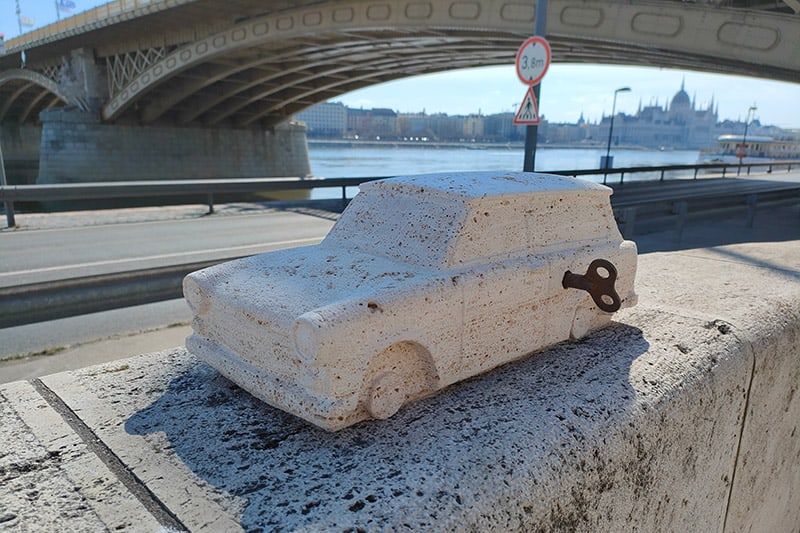
Photo: budapestflow.com
One of the most iconic symbols of the cold war era, a Trabant car, can be found on the Buda side of Margaret Bridge. Made in the spring of 2022, this Kolodko’s work is in limestone and enriches the river bank with a new photo opportunity.
Trabant cars were the most popular model in Eastern Europe. Even if their production stopped in 1991, it’s not that rare to see some of these little cars riding the streets of Budapest, a retro view that catches the attention of visitors coming from abroad. Inspired by Sputnik, the Soviet satellite, Trabant cars were nicknamed “Trabi”.
Kolodko’s mini statue of the car that was “mini” by itself, represents a wind-up toy: both the car, and the toy version, were common in Hungary during Soviet times (and both of them are hot for collectors nowadays).
Trabant
Skála Kópé
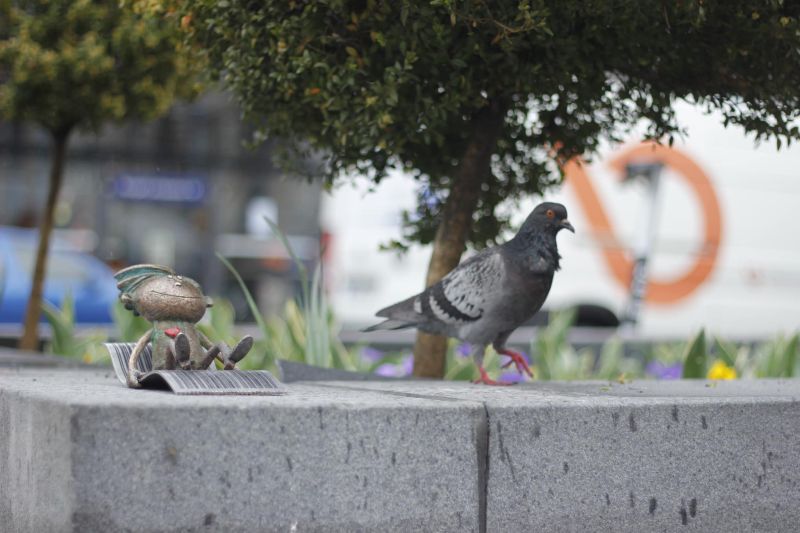
Photo: kolodkoart.com
Kolodko unlocks the memories of thousands of Hungarians with a tribute to Kópé, the cartoon mascot of the main Hungarian retail chain in the Eighties.
In Socialist Hungary, the opening of the Skálá stores was welcomed as a sign of progress. Skálá stores, in fact, were not directly state-owned, but they were part of a cooperative (coop). The chan was advertised on national TV by a cheeky boy named Kópé, from “Coop”, singing catchy jingles.
Now a little Kópé cheers passersby in busy Nyugati Square, where 1984’s Skálá Metró building hosts more modern stores. His heart pops outside, remembering how Skálá stores were meant to steal people’s hearts.
Skála Kópé
In vino Veritas

Photo: kolodkoart.com
Just in case we needed one more reason to visit Óbuda, now there’s a new Kolodko mini statue to search for in this off-the-beaten-path area. A tiny roman legionary is placed in the ruins of the amphitheater of Aquincum, the ancient Roman city founded on the Danube.
A jar of wine hangs from the hand of the statue, titled “In vino veritas” (“In wine, there is truth”). From the position of the legionary, he looks like he had one glass too many, and ran out of wine.
The artist had placed a similar one in Pula (Croatia). Óbuda, the old Buda, is located in the northern part of the city, and it was merged with Pest and Buda creating Budapest in 1873.
In Vino Veritas
Once upon a time, there was a dog fair in Buda
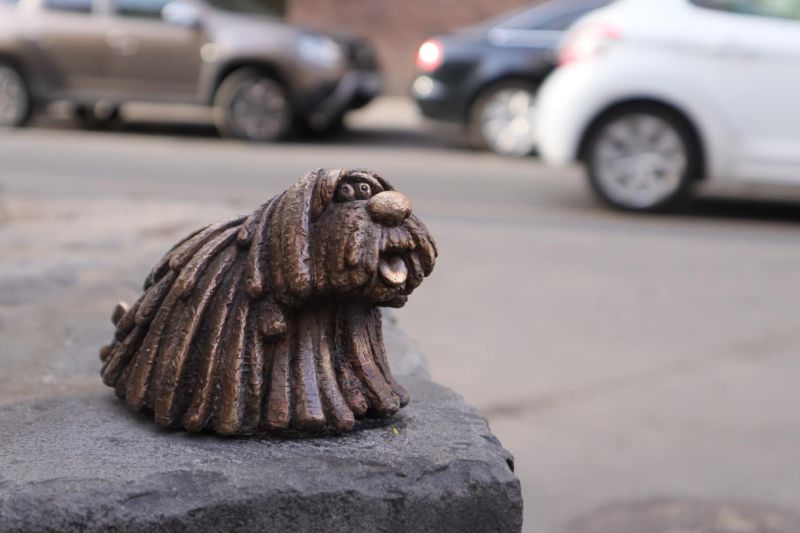
Photo: kolodkoart.com
It’s safe to say that Budapest is a dog-friendly city, and Hungarians certainly love their dogs. For how frivolous this sentence might sound, it’s true: this is one of the things visitors notice about Budapest, and it’s a prettier characteristic than the many smokers that also catch people’s attention!
Kolodko’s “Once upon a time, there was a dog fair in Buda” is a group of mini statues featuring Hungarian breeds such as Vizsla, and Puli, but also a coin with King Matthias, because of a folk tale related to him.
This particular mini statue seems to up to become an interactive monument: not only children (and older children!) are lining up to take selfies with the cuties, but some kids also brought treats to the puppies!
Once upon a time, there was a dog fair in Buda
The Russians are already in the pantry

Photo: kolodkoart.com
A Russian soldier looks inside a (mini) pantry, where a jar of jam sits empty. Behind him, there’s a chair.
The second Kolodko’s reaction to the 2022 war in Ukraine is positioned in a tiny slot between the walls of the river bank in Buda, close to the Várkert Bázár. The piece of art is crafted to fit this small space.
Out of Kolodko’s hands comes a miniaturized pantry with a functioning door. On the door, the writing “spájz” (pantry). The quote “The Russians are already in the pantry” is from the 1965 Hungarian satirical movie “The Corporal and the Others”, and it became a saying in the Hungarian language.
The Russians are already in the pantry
Among us
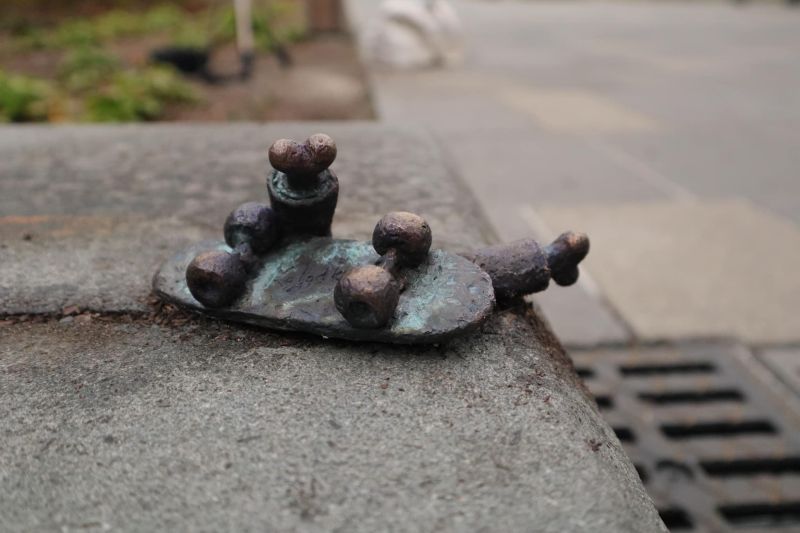
Photo: kolodkoart.com
On October 23 of 2022, Kolodko placed a mini statue of 2 boots on a skateboard, on a side of the new Ethnography Museum, in 1956’s Square. According to the artist, this is the only statue that he planned to install on a specific day: October 23 is, in fact, it’s the national holiday commemorating the revolution of 1956 against the Soviet regime.
During the revolution, the people of Budapest tore down the massive statue of Stalin which was standing right in the square by the City Park. Stalin’s boots, the only part of the statue that “resisted” the revolution, remained a symbol of the communist regime in Hungary, and this place was called “Boots Square” for years. A symbol of something stubborn, something that, according to the Ukrainian-Hungarian artist, came back in recent years, with a different name.
There are two boots, one for the past (Stalin), and one for the current oppression. The mini boots have the bones sticking out: on one side it’s a symbol for the need to cut the system that led to the current war, on the other, a reference to a popular video game “Among Us”. The boots are on a skateboard, because the new museum, which opened in May 2022, is shaped like a skate ramp.
Among Us
Ushanka Returns
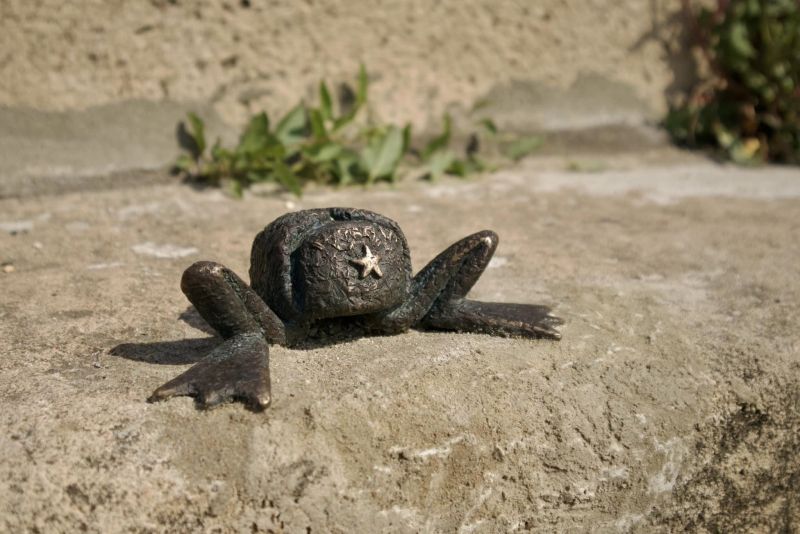
Photo: kolodkoart.com
Installed in May 2023, the mini statue of a Russian hat with a frog’s legs represents the return of an earlier Kolodko’s work. In 2019 the Ushanka (the typical winter hat) was thrown into the Danube by a right-wing member of the Parliament who removed it with an axe from its position in Liberty Square, near the monument to the Soviet soldiers who died in Hungary in WW2.
The guerilla artist had already acted upon it, installing the mini statue of an axe on the same spot. Now he made the ushanka come back from the water, right next to the House of Parliament’s visitor center.
Ushanka Returns
Chuck Norris

Photo: kolodkoart.com
What is the significance of Chuck Norris to a Hungarian bridge?
In the past, the Ministry of Economy and Transport orchestrated a two-stage online poll to bestow a name upon the bridge. Remarkably, among the top contenders emerged the moniker “Chuck Norris Bridge.”
This occurrence garnered substantial attention across various news platforms, prompting even American comedian Stephen Colbert to engage his audience in support of his own namesake, the “Stephen Colbert Bridge.” Ultimately, Colbert secured victory in the poll with a staggering 17 million votes, surpassing Hungary’s entire population by 7 million.
However, the realm of bridge nomenclature adheres to regulations. As dictated by Hungarian law, only deceased Hungarian citizens are eligible for such honors. Consequently, the Geographical Names Committee selected “Megyeri Bridge,” a suggestion put forth by an internet voter. This choice aptly reflects the connection between Káposztásmegyer and Békásmegyer.
A recent creation by @kolodko, in the form of a miniature statue, reveres Chuck Norris and is situated on the Pest side of the Megyeri Bridge.
Chuck Norris
FREQUENTLY ASKED QUESTIONS ABOUT KOLODKO’S MINI STATUES
Who is the artist?
Born in Uzhhorod in Ukraine, Mihály (alternately Mykhailo or Mihajlo) Kolodko graduated from Lviv Academy of Arts. After dabbling in larger sculptures, Kolodko decided in 2010 to devote his work solely to the miniatures he’s now become famous for.
What are these mini statues and what is the purpose of the artist?
Annoyed by the expense and red-tape surrounding larger statues, Kolodko found that the minis gave him the freedom to make exactly what he wanted quickly. Some hark back to staples of Hungarian media, others commemorate great Hungarians of the past, and there’s even a little wry political commentary in there too.
Are these guerilla sculptures or commissioned art?
Most are guerilla sculptures, especially the earlier ones. However, there have been commissions recently, such as the frogman, Noah’s Ark and 14-carat roadster, which depict District VII’s history.
How are the statues made?
The statues are first carved from modeling clay. From this, a negative mould is made, followed by a plaster cast and another mould from that, which is then filled with liquid bronze. Once the metal has cooled, it’s sanded, polished, and shaped until you get the finished article.
Where are the mini statues located?
The sculptures can be found right across the city, hidden away in nooks and crannies on either side of the Danube. You can find exact locations on the handy map below.
Are there any Kolodko statues outside Budapest?
There are plenty in cities around Ukraine; Kolodko’s hometown of Uzhhorod in particular is full of them. Here in Hungary, you can find minis at Lake Balaton (the chocolate-loving bird, Artúr Gombóc) and Veszprém. There’s even a Kolodko in Sweden; Alfred Nobel can be found outside the Hungarian Embassy in Stockholm.
Do you offer walking tours to find the mini statues?
Sure, we do! Sign up for our small-group walking tour to learn more about the mini statues and understand Budapest’s history and culture throughout the background stories of the artworks.
Map of Kolodko’s Mini Statues
Pin this for later

RELATED WALKING TOUR
Discover an unique features of Budapest’s public art scene: the mini statues and learn about Budapest’s history and culture throughout the background stories of the artworks.




Sorry, the comment form is closed at this time.